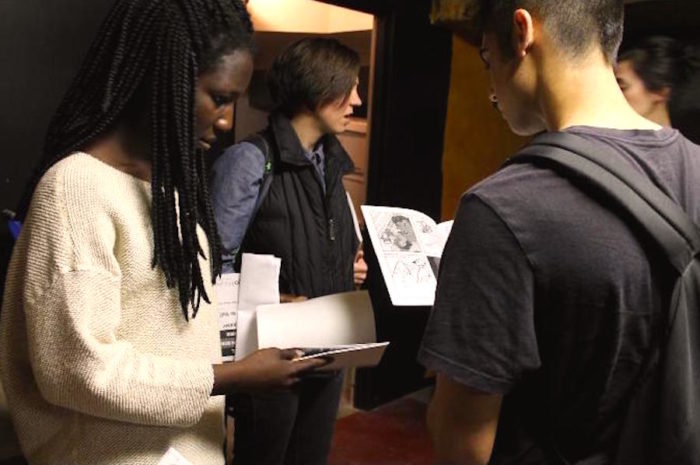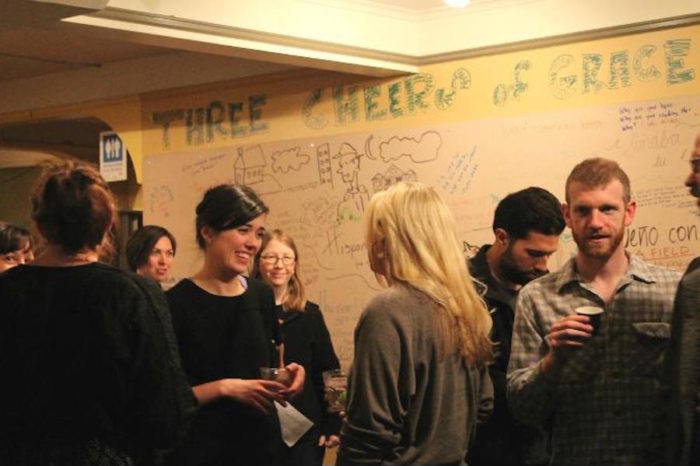
Among its neighboring buildings in Capitol Hill (now saturated with sky-high condos), Richard Hugo House stands out as a bright and charming 20th-century vestige of Old Capitol Hill.
For nearly two decades now, Hugo House has also been a gathering place to approximately 125,000 Seattle writers on the corner of Eleventh Avenue and East Olive Street. I’m one of them. Since I first walked through the doors of this old periwinkle building in 2013, I haven’t seen much change until now. Last week, Hugo House moved its programs temporarily to 1021 Columbia Street next to the Frye Art Museum. Starting on June 1, the building will be demolished to clear the way for a new six-story condo building, in which Hugo House writing programs will occupy the first-floor space.
All around, there are mixed sentiments about this nearly two-year transition.
“I have very deep feelings about this place [Hugo House],” said Karen Finneyfrock.
Finneyfrock, a nationally recognized spoken word poet and the young adult author of “The Sweet Revenge of Celia Door” and children’s book, “Starbird Murphy and the World Outside,” first began attending Hugo House programs as a participant in 2003. Within the next few years, she began teaching at the Hugo House’s summer camp, Scribes, and between 2009 and 2010 served as one of Hugo House’s writers-in-residence.
“I haven’t really accepted that I’m never going to step foot into those classrooms again,” she said.
The last few times I stepped foot in the Hugo House I could not help, but reflect on my first visit to their classrooms. My first class in 2013 was called “Write Time,” taught by Finneyfrock herself. Teens from all over Seattle gathered there once a week to have an hour of writing.
The first time I attended I was in near tears at the fear of engaging with all of these new people, but Hugo House environment, welcoming community and instruction quickly won me over with its charm and informal nature.
Events and programs at Hugo House that have continued to shape my life for the last three years. For me, Hugo House, has always been stable. No matter how many times I moved or changed friend groups, it was always there for me. But the move changes what I know Hugo House as.
Hugo House’s facilitative community and regular writer-spotlighting performances have made it such a magical space for so many people.
Hugo House also has built the literary clout to bring in the biggest writers from around the country to its doors, including Daniel Handler, who is an international bestselling novelist and screenwriter, and Roger Reeves, an award-winning poet.

Hugo House assures, on their website, that you can expect the same “number” and “caliber” of events while Hugo inhabits their temporary space next to The Frye, even going as far as to promise new programs beginning in the coming months.
In fact, Hugo House programs have already outgrown its old space. Aside from sharing the updated space with condo residents, Hugo House is also looking forward to twice as many classrooms, updated furniture, consistent heating and air conditioning, and an event room that will hold up to 150 people.
The owners of the property have already gifted Hugo House with $1.5 million of the funds and Hugo House is currently requesting additional funding from local public sources on the city, county, and state level before launching fundraising efforts among private donors to make up the remaining estimated $2.5 million.
But there is no doubt that “Old Hugo” will be sorely missed. Last Friday evening, Hugo lovers flocked to the last event held at the building where there were drinks, singing, and “farewell” scribbles on the wall.
On June 1, when the building’s demolition begins, many Hugo House supporters will be standing across the street in front of Cal Anderson park watching for a final farewell.
After talking with youth members of Hugo House the organization was described to me as, “necessary”, “home,” and “invaluable.”
Now, in my third year of involvement with Hugo House, I would describe the House as, “evolving.”
For updates on Hugo House’s events and programming, check out their Facebook and website.
Editor’s note: This story has been updated since its original publication to clarify that Hugo House’s temporary space is located next to the Frye Art Museum on 10121 Columbia Street, not inside the museum as originally reported.

